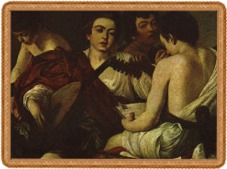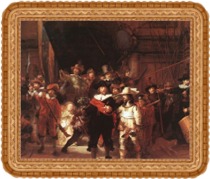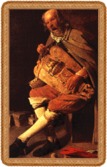|
   
 The Baroque
In Baroque art, there is a tendency
to emphasise light and colour, and painting becomes more and more complex.
The "academic" school
tended to beautify the picture and remove
anything ugly. Beautification is out of decision, and that is the
difference between baroque art and classic art, for which this was its
unconscious nature. The "naturalist" school,
however, tended to show nature more reliably, and to paint scenes
as they appeared in reality, despite their ugly or unaesthetic look. Rubens
The Baroque
In Baroque art, there is a tendency
to emphasise light and colour, and painting becomes more and more complex.
The "academic" school
tended to beautify the picture and remove
anything ugly. Beautification is out of decision, and that is the
difference between baroque art and classic art, for which this was its
unconscious nature. The "naturalist" school,
however, tended to show nature more reliably, and to paint scenes
as they appeared in reality, despite their ugly or unaesthetic look. Rubens ,
one of the famous Flemish painters, painted colour pictures (instead of
colouring sketches drawn in advance), and incorporated scenes from his
surroundings in his sacred paintings, rather than from his own imagination.
Velasquez ,
one of the famous Flemish painters, painted colour pictures (instead of
colouring sketches drawn in advance), and incorporated scenes from his
surroundings in his sacred paintings, rather than from his own imagination.
Velasquez brought the art of painting towards the implied, rather than the detailed
(which will gain him admiration among the impressionists - see this school
below, later in history). Rembrandt
brought the art of painting towards the implied, rather than the detailed
(which will gain him admiration among the impressionists - see this school
below, later in history). Rembrandt also supported the so-called "naturalism", as did the Dutch painters
who specialised in landscape painting, an area that benefited from a growing
demand. Dutch painting, effected by the Protestant prohibition against
many themes, found beauty and innovation in landscapes.
Baroque architecture focused on diversification
and surprise, whereas the Catholic Church's main demand is to draw believers
inside, and therefore architecture (as well as church painting and sculpture)
tried to glorify appearance. Italian painters were
also mobilised for the cause, and drew giant frescos on church walls and
ceilings, and large halls. Baroque construction
is impressive in size, variety and magnificence. Baroque
musicians such as Bach
also supported the so-called "naturalism", as did the Dutch painters
who specialised in landscape painting, an area that benefited from a growing
demand. Dutch painting, effected by the Protestant prohibition against
many themes, found beauty and innovation in landscapes.
Baroque architecture focused on diversification
and surprise, whereas the Catholic Church's main demand is to draw believers
inside, and therefore architecture (as well as church painting and sculpture)
tried to glorify appearance. Italian painters were
also mobilised for the cause, and drew giant frescos on church walls and
ceilings, and large halls. Baroque construction
is impressive in size, variety and magnificence. Baroque
musicians such as Bach and Händel
and Händel were asked to do the same, and therefore composed
music built splendidly down to the very last detail, in volume and quality
whose purpose is to magnify impression and intensify belief.
The Protestant church and the Church of England objected
to this trend and turned, as part of the ideological conflict, to greater
simplicity and modesty, maintaining classic beauty and avoiding staggering
external glorification. Support for artists was much smaller, and Protestant
painting concentrated on portraits of known figures.
were asked to do the same, and therefore composed
music built splendidly down to the very last detail, in volume and quality
whose purpose is to magnify impression and intensify belief.
The Protestant church and the Church of England objected
to this trend and turned, as part of the ideological conflict, to greater
simplicity and modesty, maintaining classic beauty and avoiding staggering
external glorification. Support for artists was much smaller, and Protestant
painting concentrated on portraits of known figures.
|